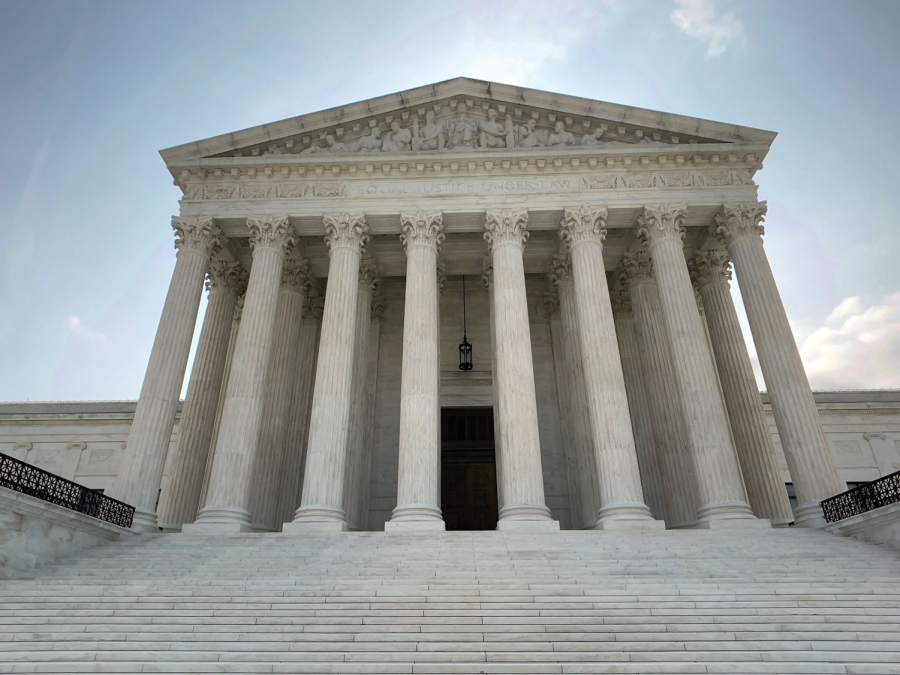A fight for our rights
As a new precedent has been set, there have been questions from the public about what the next overturn may be.
Sep 7, 2022
With midterms just around the corner, it seems that abortion rights will be on the line for many Iowans
It’s been 122 days since Politico published the leaked draft of Justice Samuel Alito’s majority opinion for the Dobbs v. Jackson Women’s Health Organization. It’s been 69 days since the opinion was handed down from the courts. Since then, 13 states have had trigger bans on abortion go into effect after the decision. There’s 213 pages of decision that goes into the Dobbs case. After sifting through the majority opinion, concurrences and the dissent, it’s incredibly clear how Dobbs v. Jackson Women’s Health stands as a precedent. Some may believe that the Dobbs v. Jackson Women’s Health Organization case is a lesson. But, in reality, the Dobbs case is a warning.
“Abortion presents a profound moral issue on which Americans hold sharply conflicting views. Some believe fervently that a human person comes into being at conception and that abortion ends an innocent life. Others feel just as strongly that any regulation of abortion invades a woman’s right to control her own body and prevents women from achieving full equality.” Alito states in the first sentences of his majority opinion for the court. In Alito’s majority opinion, he stresses the moral and ethical dilemma that abortion presents to the court. Alito also stresses how the Constitution never mentions abortion, and that there is no inherent right to abortion. While Alito builds his arguement around
the “moral dilemma” about abortion and the idea of the right to an abortion, he misses the key arguement that initally decided the case of Roe v. Wade. What was argued in Roe v. Wade was not the idea that there’s an explicit right to abortion baked into the Constitution, the idea that was argued was that the 14th Amendment and the inherent right to privacy protected abortion amongst other things. One of the larger arguements that Alito makes is that abortion is not deeply rooted in American history and therefore cannot be considered by the court. He writes, “Until the latter part of the 20th century, such a right was entirely unknown in American law. Indeed, when the 14th Amendment was adopted, three quarters of the States made abortion a crime at all stages of pregnancy.” The 14th Amendment was adopted in 1868. Alito’s draw to the laws around at that time is insane, considering the fact that a mere five years prior to the ratification of the 14th Amendment, the Emancipation Proclimation was first enforced. It’s a grave mistake to compare the laws at that time to the constitutionality of the right to privacy considering the why the 14th amendment was ratified in the first place, which was to protect former slaves and place limits on state’s rights. But unfortunately, majority opinion writer Alito glosses over this fact.
Following Alito’s flawed and incoherent majority opinion are three concurrences made by Justice Kavanaugh, Justice Thomas and Chief Justice Roberts. As I wrote in May, if the court comes for Roe v. Wade, they will come for other civil rights that are protected under the 14th Amendment. Thomas states this very clearly in his concurrence. “For that reason, in future cases, we should reconsider all of this Court’s substantive due process precedents, including Griswold, Lawrence, and Obergefell. Because any substantive due process decision is ‘demonstrably erroneous,’ (Ramos v. Louisiana, 590 U. S. [2020]), we have a duty to ‘correct the error’ established in those precedents, (Gamble v. United States, 587 U. S. [2019]). After overruling these demonstrably erroneous decisions, the question would remain whether other constitutional provisions guarantee the myriad rights that our substantive due process cases have generated.” What Thomas and Altio make incredibly known in their decisions is the fact that they want to essentially overturn the power of the 14th Amendment and deprive it of it’s ability to place boundaries on state’s rights when it comes to civil rights issues. The consequences of their actions and their decisions here could be immeasurable.
Justice Kavanaugh takes a different approach to his concurrence. “The issue before this Court, however, is not the policy or morality of abortion. The issue before this Court is what the Constitution says about abortion. The Constitution does not take sides on the issue of abortion. The text of the Constitution does not refer to or encompass abortion. To be sure, this Court has held that the Constitution protects unenumerated rights that are deeply rooted in this Nation’s history and tradition, and implicit in the concept of ordered liberty. But a right to abortion is not deeply rooted in American history and tradition, as the Court today thoroughly explains.” Thanks to Kavanaugh’s elementary and flimsy explaination, as a country, we can now understand this case beyond the scope of the oral arguements and Alito’s majority opinion,
which is what concurrences are made to do, right? If Kavanaugh’s target audience with his concurrence is first graders, he hit the nail on the head. Unfortunately, no one reads concurrences to hear the majority opinion regurgitated and repackaged as if the writer is having an earth-shattering idea, and Kavanaugh’s concurrence fails to go beyond the scope of the majority opinion, falling flat amongst the other concurrences.
Chief Justice Roberts makes an equally disappointing concurrence with a different path. His concurrence comes with judgement, meaning that he agrees with the initial ruling of Dobbs v. Jackson Women’s Health Organization, but he does not agree with the overturning of Roe v. Wade and Casey v. Planned Parenthood. Roberts’s concurrence is disappointing not because he’s essentially saying nothing, but because Roberts has recently been hailed by the Democratic party as ‘The Good One.’ He’s seen as the one conservative justice on the bench that rules outside of his own views and instead through the lens of the living document that is the Constitution. But, in his concurrence with judgement, he scrutinizes both the Roe v. Wade and Casey v. Planned Parenthood decision, along with the viability rules that the cases put into place. He claims that the right to an abortion, under the right to privacy from the 14th amendment, is ‘entangled’ in the viability rules, and he goes onto explain that that is the reason why he’s in concurrence with the majority opinion. What’s important to remember is that not one Supreme Court justice, even the ones that align with your views, can be trusted to rule fairly and justly, or even write coherent concurrences, as Kavanuagh demonstrates.
While the majority opinion is split into several concurrences, the dissent is joint, with Justices Kagan, Sotomayor, and Breyer behind a rare united decision. “Roe held, and Casey reaffirmed, that in the first stages of pregnancy, the government could not make that choice for women. The government could not control a woman’s body or the course of a woman’s life: It could not determine what the woman’s future would be.” The dissent navigates the majority opinion, the threat of established civil rights being reveresed, and touches on stare decisis, the Latin term used for the idea that the court should respect set precedent. What the dissent doesn’t quite touch on is the vague warning Alito and Thomas give in the majority and concurring opinions, which is the term ‘deeply rooted traditions.’ While it’s never explicitly defined in the decision, there’s a conclusion that can be drawn as to what is meant by “deeply rooted traditions.” If there’s a discussion around deeply rooted traditions, especially in the Constitution, you cannot leave out the simple fact that traditions that are deeply rooted in American history include racism, misogyny, xenophobia, homophobia and transphobia. The U.S government and it’s foundational documents were specifically written to exclude marginalized groups, because at the time, marginalized people weren’t even thought of as people. Legally, many marginalized groups couldn’t even be considered people, at the mercy of the Supreme Court. That idea, in and of itself, is what America was founded upon. Many courts, people, activists, politicians and judges have spend decades trying to reverse this environment and make the American government work for people that weren’t initially considered in these conversations. This decision effectively dismisses decades of work, and clears the path to continue to tear down precedents that give marginalized people the space to simply live their lives.
In the 69 days since this decision was handed down, there’s been a scramble for the power tossed carelessly to the states by the Supreme Court. In some states, there have been large movements to completely outlaw abortion, in a few, even pushes to make it a felony. Currently, in Iowa, abortion remains legal. The 24-hour waiting period prior to an abortion and the 20-week viability date restrict access, but nevertheless, it remains legal. While Reynolds begs the Iowa Supreme Court to reevaluate the injuntions placed on different restrictive abortions laws that she attempted to pass prior to the overturning of Roe v. Wade and Casey v. Planned Parenthood, the law remains the same for now. In other states, there have been strong protections to abortion rights. In states like Montana, their state constiution does enumerate the explicit right to an abortion. While they have viability laws, it’s still protected, similarly to states like Minnesota and Nevada. But, in a larger scope that state power, is the known fact that abortion can be codified at the federal level, and it just simply hasn’t. Most recently by the Biden administration has been the erasure of student debt and an extension of payments. In many college students’ eyes, this is a great advantage, and it’s greatly boosted Biden’s approval ratings over the past week. But, we mustn’t forget how violently the Democratic Party the Obama and Biden administrations have failed Americans when it comes to failing to codify Roe v. Wade into federal law. Actions speak louder than words. The emails begging for funding and voting directly after the decision was handed down is irrevicoably unforgivable. Outside of the years that the Democratic Party has had to codify Roe v. Wade, at the very least, they had two months to protect the people they were elected to represent. Yet there is only one movement, at the federal level, to push one of the platform issues of the party through the Senate. The Reproductive Freedom for All Act is quite literally too little, too late. The Democratic Party failed its constituents at all levels, then asked for money to do it again. The career politicians of this party will continue to ask you to vote for them. The only answer is to vote for the candidates primarying them at midterms. There is no one else to blame for the continued procrastination and failures than the Democratic party.
What happens next is incredibly unclear. The reversal of a right that’s been in place for decades is dumbfounding, and although it’s been over two months, we are still feeling the initial effects of it. At the heart of this issue is this: we are going beyond the scope of reproductive rights. We must. Clearly, Justice Thomas intends to expand this scope to other cases, as outlined in his concurrence. If the Democratic Party doesn’t get ahead of that curve, there will be yet another wave of disappointment, shock and anger, when a landmark case like Roe v. Wade or Casey v. Planned Parenthood gets overturned. The majority of the Supreme Court outlined their plan to the American people. It is no secret. That is why Dobbs v. Jackson Women’s Health Organization it not a lesson. There is little to nothing to learn from this situation. This decision is a warning. If the organizational leadership that was elected to represent the will of the people fails once again to heed these warnings from the Supreme Court, the civil rights and liberties granted by the 14th Amendments will slowly begin to disappear.

















